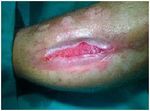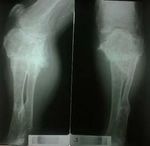World Journal of Surgery and Surgical Research
←
→
Page content transcription
If your browser does not render page correctly, please read the page content below
World Journal of Surgery and Surgical Research Case Report
Published: 28 Feb, 2019
Compartment Syndrome after Corrective Tibia Osteotomy
in Patient with Metaphyseal Aclasia - A Case Report
Milan Samardziski1*, Gramatnikovski N2, Atanasov N1, Selmani R3, Dalipi R1 and Todorova T1
1
Department of Musculoskeletal Tumors, University Clinic for Orthopedic Surgery, Republic of Macedonia
2
Department of University Clinic for Thoracic and vascular Surgery, Republic of Macedonia
3
Department of University Clinic for Digestive Surgery, Republic of Macedonia
Abstract
Compartment syndrome is defined as a condition in which a closed anatomic compartment’s
pressure increases to such an extent that the microcirculation of the tissues in that compartment is
diminished. The compartment syndrome is mostly diagnosed on variation in clinical symptoms and
signs in sequential examinations. If the diagnosis is missed and left untreated, it can lead to serious
damage to the soft tissues of the limb including muscles, nerves, and vessels. It can sometimes result
in limb loss or even loss of life. We report a case, a 29-year-old mail patient with metaphyseal aclasia
who postoperatively developed anterior compartment syndrome, after corrective tibia osteotomy.
Keywords: Compartment syndrome; Tibia osteotomy; Metaphyseal aclasia
Introduction
Compartment syndrome is a condition in which the pressure in a closed compartment increases
to such an extent that the microcirculation of the tissues is diminished [1]. In most of the cases it
is diagnosed based on the variation of the clinical symptoms and signs in sequential examinations.
If its missed or not treated on time it can lead to serious damage to the soft tissues of the limb
including nerves, vessels and muscles in some cases even with limb loss or loss of life [1].
OPEN ACCESS We report a case, of a 29- year-old man with metaphyseal aclasia who developed compartment
*Correspondence:
syndrome, after corrective tibia osteotomy.
Milan Samardziski, Department of Case Presentation
Musculoskeletal Tumors, University
We report a case, of a 29-year-old man with metaphyseal aclasia of both legs. The patient was
Clinic for Orthopaedic Surgery, Skopje,
diagnosed with this condition in 2001, after he accidentally fell of his bike and he couldn’t extend
Macedonia (FYRO),
his leg. The diagnose was made due to clinical examination and X-ray. He has previous history of
E-mail: milan_samardziski@yahoo.com
multiple corrective orthopedic surgeries of both legs and one surgery for resection of giant benign
Received Date: 28 Jan 2019
tumor of the tibia. Year and a half ago, he was admitted in our clinic for performing corrective
Accepted Date: 26 Feb 2019 tibia osteotomy due to his metaphyseal aclasia of his left leg. One day after the surgery he started
Published Date: 28 Feb 2019 complaining of pain and swelling in his left leg, and the 3rd day after the surgery he developed
Citation: Compartment syndrome with risk of developing gangrene. Fortunately it was treated on time with
Samardziski M, Gramatnikovski N, decompression of the compartments and tissues and long term therapy with NPWT (Negative
Atanasov N, Selmani R, Dalipi R, Pressure Wound Treatment).
Todorova T. Compartment Syndrome
Discussion
after Corrective Tibia Osteotomy in
Patient with Metaphyseal Aclasia - A Compartment syndrome is a term that describes a syndrome and not a disease, as there are
Case Report. World J Surg Surgical many diseases and pathophysiological processes that lead to such a scenario [2]. It is defined as
Res. 2019; 2: 1109. increased pressure within a fibro-osseous space resulting in decreased tissue perfusion to structures
within that space [3]. The compromised microcirculation in an acute setting in most of the cases
Copyright © 2019 Milan Samardziski.
may lead to potentially irreversible neuromuscular ischemic damage, and its sequelae [4].
This is an open access article
distributed under the Creative Misdiagnosis of Compartment Syndrome was firstly described by Volkmann in 1881. His
Commons Attribution License, which landmark article described the ischemia of the limb that was left untreated for several hours which
permits unrestricted use, distribution, led to paralytic contracture [5]. In that time the prevailing theory was that the ischemic insult was
and reproduction in any medium, caused by the tight bandages. Two types of compartment syndrome are described in the literature –
provided the original work is properly acute and chronic [3]. Acute Compartment Syndrome (ACS) in most of the cases occurs after limb
cited.
trauma, commonly affecting the lower limb. In this kind of situation decompression by extensive
Remedy Publications LLC., | http://surgeryresearchjournal.com 1 2019 | Volume 2 | Article 1109Milan Samardziski, et al., World Journal of Surgery and Surgical Research - Orthopedic Surgery
a b c
d e
f g
Figure 1: a) Radiography of deformity of the left tibia before the operation, b) postoperative radiography, c) radiography after the osteosynthesis extraction, d)
photo of the left shin with anterior compartment syndrome developed, skin bullae and edema, e) NWPT applied on both skin incisions with sponge bridge, f)
photo of the wound before osteosynthesis extraction, g) spontaneous epithelization of the treated wounds after four months Negative Wound Pressure Treatment
(NWPT).
fasciotomy is needed. On the other hand, chronic compartment pulseless limb and paresthesia present late in the disease process,
syndrome typically presents with exercise – induced pain, which often after damage to the structures, and they should not be part of
is commonly seen in athletes [4]. ACS needs urgent attention and the routine diagnostic criteria for acute compartment syndrome [11].
intervention and it is more worrying. Ischemia of up to 6 hrs is
The traditional treatment for lower extremity compartment
associated with irreversible changes more likely to produce functional
syndrome includes two-incision, four-compartment fasciotomy
impairment [6,7]. [12,13]. In our case we made lateral incision to decompress the
A proper diagnosis of compartment syndrome is important anterior and lateral compartments. On the other hand medial incision
because of direct morbidity to the patient and because it creates a decompresses the superficial and deep posterior compartments.
high – risk medical – legal environment for the provider [8]. The The most important step of the intervention is to make complete
classic signs of acute compartment syndrome include the 6 “P’s”: fasciotomy and release of the pressure [14]. We made the lateral
pain, poikilothermic limb, paresthesia, paralysis, pulseless limb and incision from the tibia tuberosity to just above the lateral malleolus.
pallor. Usually the initial complaint of the patient is the pain and that We continued the incision deep through the subcutaneous tissue,
should trigger the work up of acute compartment syndrome. In most and we performed a fasciotomy to enter the anterior compartment.
of the cases the diagnosis is unclear, and monitoring of the pressure We performed an extension via longitudinal incision along the entire
is required, If the clinical diagnosis of compartment syndrome is length of the fascia with blunt- tipped scissors. The intramuscular
confirmed, it should be followed by surgical decompression. However, septum is identified by its perforating vessels.
the absence of pain cannot negate the possibility of compartment Alternatively, transverse incision over the suspected site of
syndrome. There are several case reports that describe patients with the septum to confirm the location of the anterior and lateral
acute compartment syndrome who never felt pain [9,10]. Paralysis, compartments could be made [15].
Remedy Publications LLC., | http://surgeryresearchjournal.com 2 2019 | Volume 2 | Article 1109Milan Samardziski, et al., World Journal of Surgery and Surgical Research - Orthopedic Surgery
Conclusion 7. Huard J, Li Y, Fu FH. Muscle injuries and repair: current trends in research.
J Bone Joint Surg Am. 2002;84-A(5):822-32.
In the end, compartment syndrome of the lower leg is rare, but
8. Bhattacharya K, Catherine AN. Acute compartment syndrome of the
very serious complication and a surgeon should be aware of it. The lower leg: changing concepts. Int J Low Extrem Wounds. 2003;2(4):240-2.
awareness of the surgeon of this complication and the appropriate
clinical examination are the two most important steps in diagnosing 9. Badhe S, Baiju D, Elliot R, Rowles J, Calthorpe D. The ’silent’ compartment
syndrome. Injury. 2009;40(2):220-2.
compartment syndrome. This entity should be urgently treated,
especially ACS on contrary it can lead to devastating complications 10. Wright JG, Bogoch ER, Hastings DE. The ’occult’ compartment syndrome.
and morbidity for the patient. J Trauma. 1989;29(1):133-4.
References 11. Morrow BC, Mawhinney IN, Elliott JR. Tibial compartment syndrome
complicating closed femoral nailing: diagnosis delayed by an epidural
1. Tuckey J. Bilateral compartment syndrome complicating prolonged analgesic technique--case report. J Trauma. 1994;37(5):867-8.
lithotomy position. Br J Anaesth. 1996;77(4):546-9.
12. Feliciano DV, Cruse PA, Spjut-Patrinely V, Burch JM, Mattox KL.
2. Malbrain ML, Roberts DJ, Sugrue M, De Keulenaer BL, Ivatury R, Pelosi Fasciotomy after trauma to the extremities. Am J Surg. 1988;156(6):533-6.
P, et al. The polycompartment syndrome: a concise state-of-the-art review.
Anaesthesiol Intensive Ther. 2014;46(5):433-50. 13. Dente CJ, Wyrzykowski AD, Feliciano DV. Fasciotomy. Curr Probl Surg.
2009;46(10):779-839.
3. Fraipont MJ, Adamson GJ. Chronic Exertional Compartment Syndrome. J
Am Acad Orthop Surg. 2003;11(4):268-76. 14. Ritenour AE, Dorlac WC, Fang R, Woods T, Jenkins DH, Flaherty SF, et al.
Complications after fasciotomy revision and delayed compartment release
4. McDonald S, Bearcroft P. Compartment syndromes. Semin. Musculoskelet in combat patients. J Trauma. 2008;64(2):S153-62.
Radiol. 2010;14(2):236-44.
15. Owen C, Cavalcanti A, Molina V, Honoré C. Decompressive fasciotomy
5. Konig F, Richter E, Volkmann R. Die ischaemischen Muskellahmungen for acute compartment syndrome of the leg. J Visc Surg. 2016;153(4):293-
und Kontrakturen. Centralblatt Fur Chirurgie. 1881;51:801-3. 6.
6. Rorabeck CH, Clarke KM. The pathophysiology of the anterior tibial
compartment syndrome: an experimental investigation. J Trauma.
1978;18(5):299-304.
Remedy Publications LLC., | http://surgeryresearchjournal.com 3 2019 | Volume 2 | Article 1109You can also read






















































